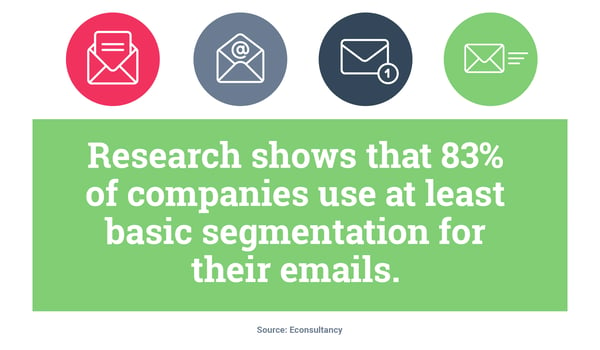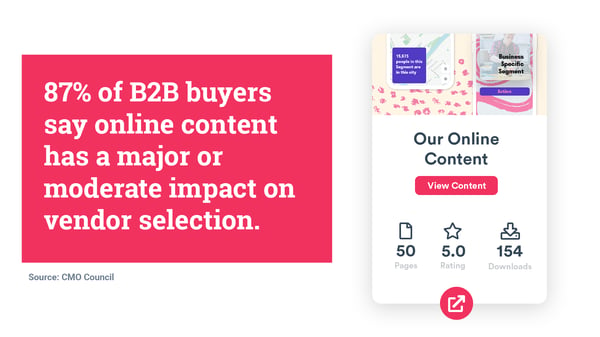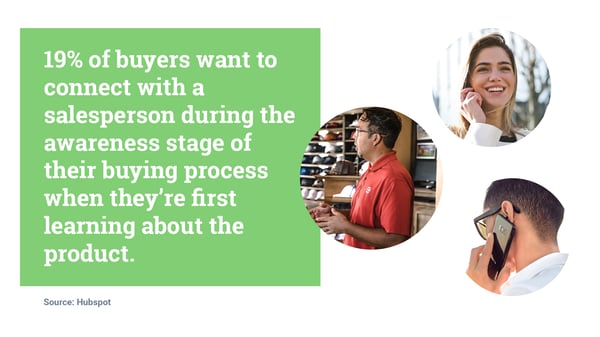7 Essential Elements of Firmographic Segmentation
Market segmentation is essential for marketers - creating an accurate picture of your audience allows you to target them more effectively and optimise their user experience, resulting in happy (valuable) customers.
There are usually four main types of market segmentation: demographic, psychographic, geographic and behavioural. Each of these offers its own unique and constructive actionable insights. But there’s one other type that often gets overlooked: firmographic segmentation.

What is firmographic segmentation?
Firmographic segmentation is the process of analysing B2B audiences and grouping them based on their shared characteristics. Firmographic data is gathered and analysed to better understand the target audience in terms of their needs, wants and what they might offer in return.
Where does the term come from? It’s a combination of "firm" and "demographic". In this context, "firm" refers to a company or business entity, and "demographic" is borrowed from the field of demographic segmentation.
The merging of "firm" and "demographic" into "firmographic" refers to demographic segmentation principles within businesses or firms. It's a way of categorising companies based on specific characteristics and attributes, similar to how demographic segmentation categorises individuals based on personal characteristics. Firmographic segmentation, therefore, involves analysing and categorising businesses based on various firm-specific attributes to better target and serve them.
Essentially, B2B companies use firmographics for organisations in the same way that B2C companies use demographics for people.
While there are countless variables that B2B entities can use, there are typically 7 main elements of firmographic segmentation:
- Industry
- Location
- Company size
- Status
- Performance
- Executive title
- Sales cycle stage
1. Industry
In firmographic segmentation, the term "industry" refers to the categorisation of businesses or organisations based on the type of products or services they primarily provide or the core activities they are involved in. It’s a way of classifying companies into specific sectors or fields, such as technology, healthcare, finance, manufacturing, retail, agriculture, etc. to understand their distinct characteristics, needs, and behaviours.
For instance, a SaaS business will have different needs compared to a high-end fashion retailer. Industry segmentation is essential for businesses to target and tailor their products, services, and marketing strategies to effectively meet the unique requirements of different industries.

2. Location
What is the geographical location or physical presence of a business or organisation? The answer to these questions, in firmographics, is location. It involves categorising companies based on their geographic area, which can be as specific as a particular city or region, or more broadly, such as by country or continent.
Location segmentation helps businesses understand the regional or local variations in their target markets, allowing them to adapt their marketing strategies, products, or services to meet the specific needs and preferences of customers in different locations. This type of segmentation can be crucial for businesses looking to expand into new geographic markets or for those seeking to address location-specific challenges and opportunities.
The location of a firm will always affect a consumer’s likelihood to buy and will also affect a brand’s ability and motivation to sell and distribute. Analysing the geographic characteristics of a business’s location can help B2B marketers measure the areas that will likely be fruitful for them and where their brand, product or service can bring value to consumers in return.
3. Company Size
In firmographics, company size is defined by two things: annual revenue and number of employees.
- Annual Revenue
When it comes to segmentation, revenue is a key factor because what you’re offering has to be affordable to your current and prospective consumers. If the price of the product or service you’re offering is disproportionate to the revenue of your target segment, any marketing or outreach you do will fail.
To avoid this, research is essential. Is your target market a Fortune 500 or are they a small start-up? Has their revenue fluctuated over the years or are they steady earners? These are the kinds of questions that will guide your data collection and ensure that your firmographic segmentation outcomes are reliable and therefore actionable.
- Number of Employees
There is no official set of criteria that establishes whether a business is large or small. However, according to the U.S Small Business Administration, companies that employ 1,500 people or less can be deemed small businesses.
The number of employees an organisation has is a good indicator of its current market position, which can, in turn, impact your marketing and sales strategy; the needs of a local news agent will generally be different from those of a global conglomerate. Therefore, your brand’s targeting strategies will also be different - are you targeting a brand that’s in multiple countries? What are their purchasing power and distribution abilities? Are they likely to be long-term returning customers or will a one-off purchase suffice?

4. Status
In firmographic segmentation, "status" typically refers to the legal or operational status of a business or organisation. This can include various categories, such as:
1. Business type: Identifying whether the entity is a sole proprietorship, partnership, limited liability company (LLC), corporation, nonprofit, or any other legal business structure.
2. Company size: Determining the size of the organization, often categorized by the number of employees, revenue, or assets.
3. Ownership: Understanding whether the business is privately owned, publicly traded, government-owned, or part of a larger corporation.
4. Nonprofit status: Identifying if the entity has nonprofit or tax-exempt status, which is common among charitable organizations and associations.
5. Franchise or independent: Distinguishing between franchise businesses and independently operated businesses.
6. For-profit or not-for-profit: Categorising organizations as either for-profit, seeking to generate revenue, or not-for-profit, focused on fulfilling a mission without the primary goal of making a profit.
Firmographic status is of paramount importance because it's the compass that guides businesses through the vast sea of potential clients, ensuring they sail in the right direction. By recognising the status of an organisation, you can tailor your strategy more effectively to meet the precise needs of your potential customers.
For instance, when you're dealing with a local partnership or a small limited company, your approach may differ significantly from when you're pitching to a multinational corporation or a non-profit organisation.
5. Performance
In firmographic segmentation, "performance" refers to the evaluation and measurement of how well a business or organisation is doing in terms of its objectives, goals, and key performance indicators (KPIs). It's a British spelling of the term "performance," which assesses how effectively a company is meeting its targets, whether it's achieving growth, generating revenue, or achieving specific milestones such as:
- Employee growth
- Profits and/or losses
- Increase or decrease in revenue
Assessing the performance of businesses in firmographic segmentation helps you identify potential clients or partners that are in a phase of growth, in need of specific services, or experiencing particular challenges. It allows businesses to offer tailored solutions that can address the unique performance-related needs of each organisation. Understanding the performance of different firms is vital for effective market targeting and building successful business relationships.
Segmenting based on performance over time is an effective way to understand the current position of an organisation and predict its future behaviour, therefore helping you to tailor your marketing and sales efforts as much as possible.
6. Executive title
In firmographic segmentation, "executive title" is the specific job titles or positions held by individuals within an organisation's executive or leadership team. Understanding executive titles is crucial because it allows you to identify decision-makers and key influencers within an organisation. This means you can tailor your communication and marketing strategies to address the specific concerns, priorities, and decision-making processes of those executives.

Are you targeting CEO or the CFO? Or maybe the marketing director? Knowing who might be a dependable buyer will ensure that you don’t waste your time and money on targeting the wrong decision-maker, and also allows you to further personalise targeted content or emails.

7. Sales cycle stage
In firmographic segmentation, the "sales cycle stage" is like a compass guiding businesses through the winding journey of turning prospects into loyal customers. Are they in the awareness stage i.e. are they just getting to know your brand and exploring other possibilities? Are they in the consideration stage where they’re contemplating your brand as a viable option for them? Are they in the decision stage where they have concluded that your brand has everything they need and have chosen you over your competitors?
Imagine it as the various checkpoints or milestones that potential customers pass through in their purchasing journey. Each stage represents a different level of engagement and commitment, moving from initial awareness to making a final decision.
Take a look at the ad below:
This ad is targeting those at the consideration stage of the sales cycle. There is little explanatory text as the ad is not for awareness-stage viewers. Those in the consideration stage of the sales cycle have already read about Hurree and our analytics platform. They know what we do, and this ad is offering viewers a chance to try Hurree for free - before deciding whether or not Hurree's segmentation platform is right for them.

Understanding where the consumer sits in your sales cycle helps with your lead nurture process by offering insight into the requirements of these current or prospective customers, which enables you to push them through to the next stage.
Summing up
Firmographic segmentation, while not as well known, is crucial for any B2B organisation. Why? Because it's all about precision. By understanding crucial business attributes like industry, location, company size, and more, you can tailor your marketing efforts to perfection. It's like having a laser-guided marketing strategy.
Did you know that firms using firmographic segmentation in their marketing strategies experience a whopping 166% increase in customer engagement? That's the power of getting to know your audience intimately.
Key benefits of firmographic segmentation:
- Increase in sales and ROI
- Identifying new opportunities
- Improving promotional tactics
- Understanding current and prospective consumers
It demonstrates that you don’t need to cast a wide net; firmographics help you zoom in on the right prospects that are more likely to convert to paying customers. This means your marketing campaigns will be sharper, your engagement will soar, and your business will thrive.
Track and visualise your content marketing metrics in real-time with a Hurree dashboard. Sign up for your free trial today and discover how to truly harness the power of analytics and transform your company reporting. If you have any questions then feel free to reach out to contact@hurree.co, we'd be happy to answer them!
Share this
You May Also Like
These Related Stories

Firmographic Segmentation: 7 Essential Elements

What is Psychographic Segmentation: The Basics for Marketers


